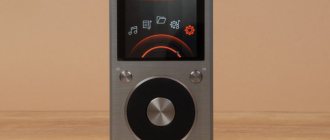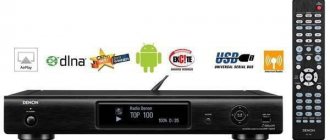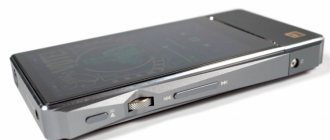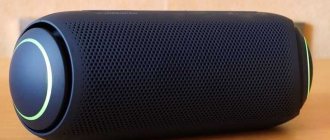Each new product from Fiio is most often doomed, if not to resounding success, then to occupying a worthy niche in the market. This is not surprising, since most often it is Fiio that defines these niches, each time forcing users to reconsider their views on what they can get for their money. Their players Fiio X3 and Fiio X5 have gained popularity around the world. Now a new, budget model Fiio X1 is entering the market with a planned price of $100. What do the company's developers offer for this money?
Initial rumors about Fiio X1 suggested that the player would be built on a simple codec instead of a full-fledged DAC chip, which made it indistinguishable from the row of already existing good players, but then Fiio managed to squeeze quite good hardware into a narrow price frame. PCM5142, of course, is not a top model, but still a very good DAC, and OPA2322 as an amplifier and ISL28291 as a buffer result in very good amplification for a portable device.
Of course it's a joke
There are much more differences between the two players than might seem at first glance.
Both support many lossless music formats (see table below), and X3 can also play AIFF, DSD64/128.
The entire X-line of FiiO runs on the Ingenic JZ4760B processor, but the amplifier circuits have their own characteristics. This can be clearly seen from the following picture. On board the “junior” X1 is a Texas Instruments PCM5142 .
X3 has acquired a more advanced Cirrus Logic CS4398 , which is characterized by an “energetic” sound, slightly tinted highs and mids. At the moment, for portable speakers, the CS4398 is the best solution in terms of price/quality ratio.
Interestingly, this DAC is also responsible for signal conversion in the more expensive Astell & Kern 240, only there are two of them at once - for each channel.
Additional accessories
Like the Fiio X5, the X1 promises a ton of accessories.
- Transparent hard polycarbonate case
- Leather Case
- A desktop amplifier in which the X1 will be inserted from above (like the E07K and E09K), the same amplifier will be used with the future top-end player
- An adapter to USB, which will allow you to get a linear output simultaneously with headphones (X1 uses an 11-pin MicroUSB, so the linear output is also connected to it)
- Case for carrying the player on your hand
- Mount for using X1 in a car
- Kit for using X1 with an external amplifier (same as X5 Stacking Kit)
As you can see, there are accessories for all occasions.
X3 II
Supported loseless formatsAPE, FLAC, ALAC, WMA, WAV (up to 96 kHz)APE, FLAC, ALAC, WMA, WAV (up to 96 kHz), AIFF, DSD64/128Other formatsMP3, AAC, OGG, MP2Headphone impedance range16 – 100 Ohm16 – 300 OhmPlaylistsm3u, m3u8Built-in memoryNoMemory card slotmicroSD up to 128 GBCPUIngenic JZ4760BDACTI PCM5142Cirrus Logic CS4398Volume levels100120Amplifier chipsISL28291+ OPA23222 x OPA1642 + LMH6643DisplayTFT 2” 320 x 240TFT 2” 320 x 240Equalizer7 stripes10 stripesExits3.5 mm (headphone, linear)3.5 mm (headphone, line + S/PDIF)Support for Apple/Samsung headphone remotesYesUSB OTG/DAC modeno YesBatteryLi-Pol 3.7 V/1700 mAhLi-Pol 3.7 V/2600 mAhWorking hours12:11:00Dimensions, mm56.7 x 96.7 x 14.157.7 x 96.7 x 16.1Weight, g106135Equipmentmicro USB cable, 2 screen protectors, 3 stickers per body (carbon, wood, US flag) micro USB cable, 2 screen protectors, 3 stickers per body (carbon, wood, US flag), coaxial S/PDIF adapterExternally, the gadgets are very similar. If you put them in the silicone cases included in the kit, then only a few will be able to accurately identify the model.
The X3 II is 2mm thicker, 23g heavier, and has two 3.5mm jacks instead of the X1's one. The first connector is responsible for outputting sound to headphones, and the second is also a linear and S/PDIF output.
By the way, the X1 also has a linear output, but it is combined with headphones: switching modes is done through Settings. But only the X3 II is equipped with S/PDIF (Sony/Philips Digital Interface). This protocol supports the transfer of digital audio signals from one device to another without conversion to analog, which avoids deterioration in sound quality. The kit includes a corresponding adapter.
Those who are willing to pay a little extra to own the FiiO X3 II get four more features:
- USB DAC - the device can take on the tasks of an external sound card. Works in tandem with OS X and Windows.
- USB OTG (on-the-go) is essentially an external USB port that connects to the player via micro USB to work with various peripherals. For example, Android owners will be able to stream music directly from their phone.
- The 10-band equalizer of the FiiO X3 II allows you to fine-tune the sound to suit yourself more than the 7-band equalizer of the X1.
- X3 II sounds louder and drives headphones up to 300 Ohms , X1 – only up to 100 Ohms.
Packaging and delivery
My Fiio X1 is a pre-production sample not for sale, so it came to me in a completely white box, but from the shape it is clear that the packaging of the latest version will be used: a flat square box slightly smaller in size than a CD and about 1 centimeter thick. The box traditionally has a scratch area with a code to check if your device is original.
Inside you'll find the player, immediately housed in a black silicone case (a good move, since the translucent case that Fiio used before looks worse), a USB cable and a couple of spare screen protectors (another one is already applied).
Traditionally, the kit does not include headphones, since bad headphones will not reveal the player’s potential, while good ones will double the price tag. In addition, most of the target audience probably has good headphones.
Why is the price lower than competitors?
Compared to competitors, FiiO players are 2-3 times cheaper, but sound no worse. We must understand that by paying less money, we lose some features.
Firstly, the players do not have built-in memory; music is stored on microSD (up to 128 GB).
Secondly, the manufacturer abandoned touch screens in favor of physical keys. I think this is the right move, since with a display size of 320x240 pixels it will be difficult to hit the virtual buttons with your finger. Moving through the menu items occurs using the central wheel.
Thirdly, there is no Bluetooth module.
FiiO players are distinguished by phenomenal turn-on speed. Literally 5 seconds – and the device is ready for use.
Design and management
Fiio X3 was the company’s “test balloon” in the player market; its design was developed long before its release last year and therefore was not particularly surprising. After the success of the X3, the company realized that the market was hungry for a sequel, and the X5 was already being developed with a modern design, taking as inspiration the most popular player in human history, the iPod Classic. To Fiio's credit, the X5 turned out to be quite different from the iPod, but at the same time retained its best ergonomic solutions. Of course, it would be stupid to discard successful developments, so the X1 uses a design idea similar to the X5.
The X1 itself is significantly smaller than the X5 (although the latter is generally quite large), it is exactly the size of a deck of playing cards. Thanks to its well-chosen size, the player fits into your hand like a glove, and any control can be easily reached with one hand without having to grab the device.
The body is entirely aluminum, very solid and well-fitted. They promised many color options, but I got the silver one. Fiio designers carefully worked with the shape; it is very laconic: the back side is completely flat, the corners and the front side are slightly rounded.
The main controls are located on the front panel. At the top there is a 2″ screen, which is good for a player; it is made using TFT technology, so it pleases with good viewing angles and color rendition. The lower half is occupied by the control wheel. It is not touch-sensitive, as in the iPod, since Apple protected this idea with a patent, but mechanical. Fiio took into account complaints about the free movement of the control wheel in the X5; in the X1 it is tighter. The wheel is plastic, slightly rough. I think it could have been made with more pronounced notches, but apparently Fiio decided that this option would wear off or become clogged with dirt. Or maybe they saved an option with a knurled wheel for a special version (like the X5). The center of the wheel is a button responsible for selecting menu items and play/pause.
There are control buttons on four sides of the wheel. In X1 they are round, and, taking into account the complaints about X5, they are signed. Their functions remain the same. The top left button is used to call up the context menu during playback, the top right button is for going back, the bottom two are for rewinding and moving between tracks, and they can also be used to navigate the menu.
There is an LED indicator at the bottom of the front panel (although it is not visible in the included case).
On the left side of the device there are volume control buttons and an on/off button; when pressed briefly, it locks/unlocks the device. And here the designers demonstrated attention to detail. The power button is more recessed into the body, and the volume up button has a small protrusion, so even by touch the buttons are not confused.
On the top panel there is a headphone output jack, which also serves as a line output (switching is done through the menu). On the right panel there is a slot for Micro SD cards, unlike the X5 - it is not covered by anything. On the bottom there is a Micro USB connector and a pair of screws for a pentalobe screwdriver, which must be unscrewed if you decide to lose the warranty and disassemble the player. Although I can already say now that fans of sound improvement will probably make mods in the hope of getting more than what was included in the player when it was created.
The menu has also been redesigned compared to the X5 to make it more logical. There are only five items left, and they are all displayed on the screen at the same time. The active menu item is highlighted. A funny touch is that if you use the wheel to navigate the menu, then part of the circle is shown at the bottom of the screen, but if the lower buttons are used, it is removed, thus the player shows the current control metaphor. In general, there is no failure of logic like the X5 with its inverted circle.
Menu items from left to right: returning to the playback screen, viewing the library (there is a grouping by albums, artists and genres, there is also a list of all songs and a list of tracks added to favorites), viewing music by folder on the card, playback settings and system settings. The settings are generally the same as the X5, with the exception of the external DAC mode and “only” 7 equalizer bands. It is worth noting, however, that the equalizer here, as in the X5, is software, and it is better not to use it to preserve sound quality. You can choose one of six menu color options.
In general, the player's controls are very simple and logical, the playback screen contains all the necessary information, you can figure it out in a few minutes. The firmware is very stable; no problems were found during the entire testing period. There is no Russian language in the firmware, but learning a couple of dozen necessary words in English is not difficult. In addition, unofficial Russifications are almost guaranteed to appear.
The time it took me to fully charge the battery was 3 hours 12 minutes when using an external charger, the operating time on one charge when playing 44.1/16 FLAC was 12 hours 41 minutes. Considering the size, these results can be considered very good.
conclusions
Once again, Fiio has identified a new market niche. When you hold the X1 in your hands, it’s hard to believe that it costs only $100 (price for the US market; taxes or duties may apply in other countries). The player is superbly put together, there are no complaints about the design. The sound, considering the price, is also simply excellent, and is well suited for most non-audiophile music lovers. While other manufacturers are climbing sky-high heights with players starting at $1,000 and more, Fiio thinks about our wallets and offers great solutions for those who are not ready to exchange their (or someone else’s) kidney for a player.
Sales of the player around the world begin on the 20th of September, but we can already say that we have received another bestseller.
Compatibility
Of course, 70 milliwatts is not the highest power, however, for a budget IEM-oriented player, this is more than enough. The near-zero output impedance allows it to work well with multi-drivers, both purely armature and hybrid. As expected, the player goes well with the Fiio EX1; models from Trinity Audio and other single-driver speakers are also good.
The player is omnivorous in terms of genre, but you should understand that to fully reveal complex styles such as progressive metal or, for example, orchestral classics, you need devices at a completely different price level. The player is tolerant of bad recordings; on a 10-point pickiness scale, I would give it a little less than 6 points.
As usual, a few tracks as an example
Uriah Heep - Beautiful Dream A “typical” hip song - choral singalong, interesting riff, lead synthesizer, catchy melody, everything we love about the band. The player copes well with conveying the nuances of the track, realistically conveying both guitar parts and lyrical singing.
Orphaned Land & Amaseffer - Akeda I've been waiting for the new Amaseffer album for a long time. Even though the new album is mainly the work of other geniuses of the Israeli prog scene Orphaned Land, the influence of Erez Yohanan is clearly audible here. An amazing mixture of complex progressive parts and Middle Eastern music, combined with a classic biblical story, give a definite hit. The Fiio X1-II is, of course, not an ideal player for this kind of material, but it reveals it at a very decent level.
Leonard Cohen — Treaty Did you want it darker? Leonard Cohen will give you a dose of much-coveted darkness. Despite his very advanced age, the voice of this outstanding creator still sounds the same as many years ago. Hallelujah! We have another album for those long winter nights, when the only thing that warms you up is a cold whiskey in a glass and a voice in your headphones. The new product from Fiio copes well with the track, displaying all the timbral diversity of vocals.
Whatever one may say, it’s better not to find
The devices reviewed today have a similar price category, but very different purposes.
The FiiO X1 II player is still a budget device for audiophiles, so you shouldn’t expect anything supernatural from it. On the other hand, no smartphone has such sound quality. Most players with a price tag of up to 30,000 rubles sound much worse. The presence of Bluetooth makes the X1 II a universal device, without which you can’t go to the gym or go to work.
If its capabilities are not enough, you should pay attention to the amplifier. The X1 II + A5 pairing sounds incredible and will fit with any headphones on the market. In this case, they will determine the character of the sound, leaving the quality unchanged. However, you can get by with one amplifier. This is the best iPhone companion. And it will work just as well with other smartphones.
(Be the first to vote for this article!)











